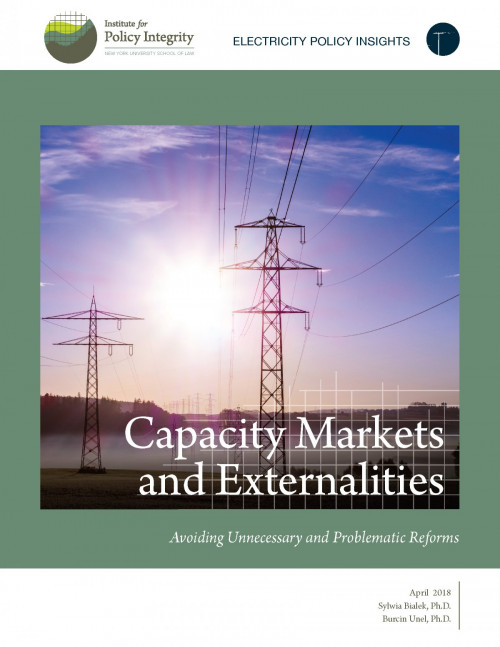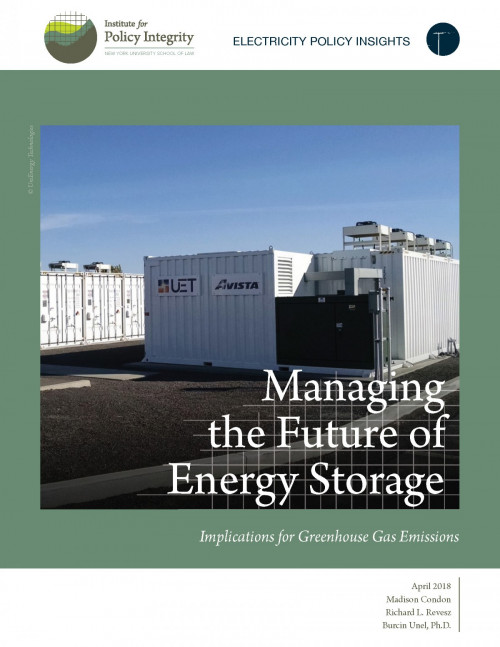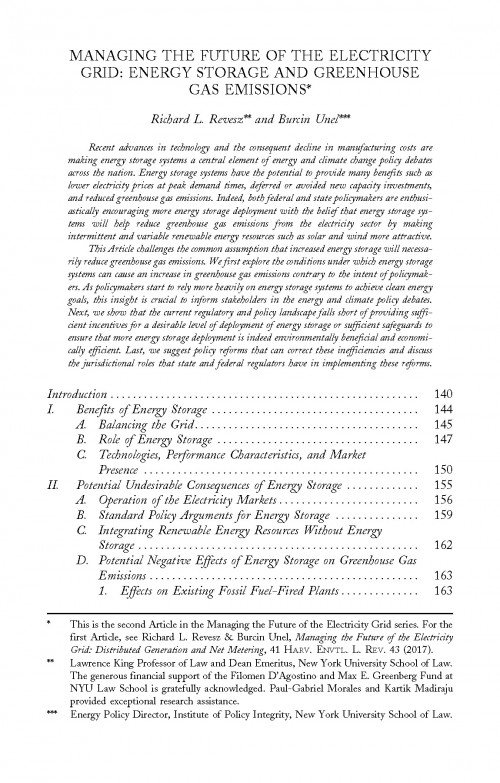-
Comments to FERC on PJM Capacity Market Repricing Proposal
PJM Interconnection, L.L.C (PJM), a regional electricity transmission organization serving 13 states and Washington D.C., recently submitted a proposal to the federal government requesting changes that would “mitigate” the impact of state climate and energy policies on electricity markets. In our comments to the Federal Energy Regulation Commission (FERC), we argue that PJM’s proposals rest on a faulty premise that state public policies are distorting the economic efficiency of capacity market price signals, which heavily affect how generators enter and exit the market.
-

Capacity Markets and Externalities
Avoiding Unnecessary and Problematic Reforms
Many states are taking action on climate change by paying zero- and low-emitting electricity generators for avoiding the emissions that fossil-fuel-fired resources would otherwise emit. These “externality payments” help level the playing field between emitting and non-emitting generators. Critics of these policies argue that these payments might negatively affect the efficiency of wholesale electricity markets by reducing capacity prices, which heavily affect how generators enter and exit the market. Our report shows why the premises underlying recent reforms, which seek to shield capacity markets from the potential price impact of pollution externality payments, are flawed.
-

Managing the Future of Energy Storage
Implications for Greenhouse Gas Emissions
Many policymakers assume that increasing deployment of energy storage will automatically reduce greenhouse gas emissions, in part by helping to integrate renewable energy resources with intermittent and variable generation. This report, published in the Harvard Environmental Law Review, explores situations in which energy storage systems can in fact lead to increased emissions, and offers reforms to correct for poor incentives while ensuring that energy storage can provide the maximum benefit possible to the grid.
-
Comments on California’s Distributed Energy Resources Policy
The California Public Utilities Commission (CPUC) is developing a comprehensive policy for integrating Distributed Energy Resource (DERs), like rooftop solar, into its energy system. A March 2018 administrative law judge ruling heavily cited our earlier comments in laying out a revised plan to require the state’s utilities to conduct a societal cost test to help compare the net benefits of different DER technologies. We submitted comments to the CPUC commending the agency for its revisions to the proposed analysis and recommending additional improvements.
-
Amicus Brief on New York’s Zero Emissions Credits and the Social Cost of Carbon
In 2016, the New York Public Service Commission adopted the Clean Energy Standard, an ambitious plan to increase renewable generation to 50% of the market by 2030. While working toward that goal, the State found it was necessary to pay nuclear generators through a zero-emissions credits (ZECs) system, as compensation for the value they provide in avoiding emissions. The State found that this would help guard against an increase in pollution if the nuclear generators were to close. Our amicus brief to the Supreme Court of New York in Albany County argues that the Commission’s decision to base ZEC prices on the Social Cost of Carbon (SCC) was reasonable.
-

Valuing Pollution Reductions
How to Monetize Greenhouse Gas and Local Air Pollutant Reductions from Distributed Energy Resources
Distributed energy resources (DERs)—grid-connected, small-scale electric generators such as rooftop solar installations, micro-turbines, combined heat and power systems, customer backup generators, and distributed energy storage systems—are a growing part of the U.S. electric system. They can help avoid the high levels of greenhouse gases and local air pollution produced by traditional energy sources. As their use grows, state electric utility regulators are seeking to compensate DERs accurately for the benefits they offer, including reductions in pollution that contributes to climate change and harms human health. This report shows how regulators can calculate the types and amount of pollution avoided, and then monetize these benefits for use in policy.
-

Managing the Future of the Electricity Grid: Energy Storage and Greenhouse Gas Emissions
Recent advances in technology and the consequent decline in manufacturing costs are making energy storage systems a central element of energy and climate change policy debates across the nation. Energy storage systems have the potential to provide many benefits such as lower electricity prices at peak demand times, deferred or avoided new capacity investments, and reduced greenhouse gas emissions. Indeed, both federal and state policymakers are enthusiastically encouraging more energy storage deployment with the belief that energy storage systems will help reduce greenhouse gas emissions from the electricity sector by making intermittent and variable renewable energy resources such as solar and wind more attractive. This article, published in the Harvard Environmental Law Review, challenges this common assumption that increased energy storage will necessarily reduce greenhouse gas emissions.
The article was selected by Environmental Law Reporter as one of the five best environmental law articles published during the 2018-2019 academic year. An adapted version, The Future of Energy Storage: Adopting Policies for a Cleaner Grid, was included in the August 2019 Environmental Law and Policy Annual Review issue of Environmental Law Reporter’s News & Analysis.
-
Comments to California on Its Cap and Trade Program
California has legislation authorizing its Air Resources Board (ARB) to extend its cap-and-trade program for carbon emissions. This extension, while defining much of the program’s structure, asks ARB to develop some design features through a regulatory process and public feedback. California’s most recent changes to the plan are consistent with our previous comments on the program, and they place California on the path to internalizing the cost of climate change from carbon emissions. Our most recent set of comments encourage ARB to continue to set the price ceiling for carbon permits at least as high as the Social Cost of Carbon set by the Interagency Working Group in 2016, as it does in its Concept Paper on carbon pricing. We also encourage ARB to allocate preferentially any unsold carbon allowances to the price ceiling, rather than to a lower price.
-
Comments on California PUC Order Instituting Rulemaking to Create a Consistent Regulatory Framework for the Guidance, Planning, and Evaluation of Integrated DERs
California has long been a trendsetter in clean energy policy, and our input helped inform the state’s approach for evaluating distributed energy resources (DERs), such as rooftop solar installations. The state’s new approach, which will quantify the environmental benefits of DERs, could help influence other policies around the country, boosting the growth of clean energy sources. Our comments to the California Public Utilities Commission were heavily cited in a March 2018 administrative law judge ruling, which, if adopted by the Commission, would require utilities to conduct a societal cost test to determine the cost-effectiveness of DERs.
-
Comments to Colorado Public Utilities Commission on Electric Resource Planning
The Colorado Public Utilities Commission is revising their electricity resource planning process. Our comments to the Commission suggest legal language for incorporating externalities, like the climate effects of greenhouse gas emissions, into the state’s electricity policy. We also explain why the Social Cost of Carbon, as developed by the federal government in 2016, is the best tool for incorporating the externalities of carbon emissions into policy. Our response comments rebut the state electric utility’s faulty arguments against using the social cost of carbon in this process, and supports the use of cost-benefit analysis in determining the best policy option.
Viewing recent projects in Electricity




